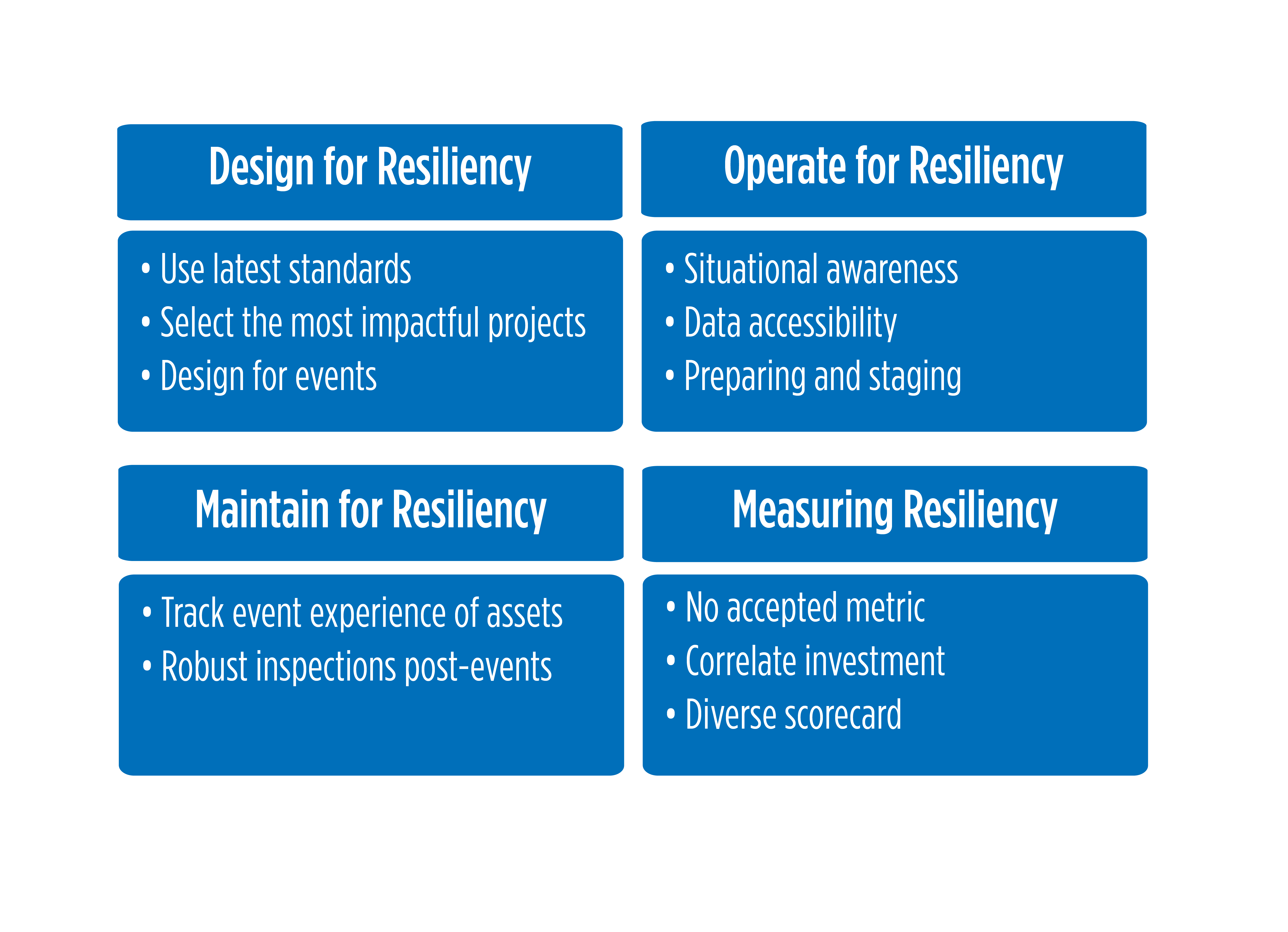Reliability has been the watchword for the power delivery industry, but attention increasingly is being paid to the resiliency of the system.
Within electrical distribution networks, reliability has been measured for a long time, giving us very mature metrics to work with. But utilities are becoming more aware of their systems’ vulnerability to significant weather events, such as wildfires, hurricanes and ice storms. Improving their resilience is a targeted effort to help these distribution systems bounce back quickly from such events, and with minimal impact.
Resiliency for electrical transmission and cybersecurity have their own challenges and strategies, which vary from those for electrical distribution. Focusing on resiliency for distribution is a multipronged proposition. A thorough strategy should consider design, operations, maintenance and measurement.
 Designing for Resiliency
Designing for Resiliency
In order to design for resiliency, utilities need to focus on updating their standards regularly, focusing on hardening and incorporating distribution automation communications and intelligence. Even if standards are updated on a regular cycle, it is not unusual to embark on a project and find that the utility is working from a version that might be three or four iterations behind. Since newer standards tend to include greater resilience requirements, a design based on standards from the year 2000 may be less resilient than one based on standards from 15 years later.
The second piece to designing for resilience is careful consideration of each utility’s capital investment program. Thorough evaluation of a program can help a utility allocate funds on targeted projects that should offer the biggest improvements.
Storm hardening, such as to design poles to withstand 130 mph winds and not just 30 mph winds, is one such example. Another is automation; the ability to reconfigure and restore circuits quickly can help utilities be better prepared for storm events. Strategic undergrounding — identifying the overhead circuits that are most vulnerable to the weather and putting them underground — also can enhance the overall resilience of a system.
Operating for Resiliency
Operational resiliency is all about situational awareness and careful preparation. Utilities need to ask whether and to what extent they are monitoring the weather and other potentially dangerous conditions that could make their system more vulnerable. Without that kind of situational awareness, an operator is flying blind.
Of course, it is not sufficient to merely collect the data. The data needs to be accessible to those responsible for operating the system so they can prepare it for a threat. Adaptive relaying can help operators change a network’s configuration to optimize it for a weather event. Flexibility helps operators maintain resilience in such scenarios.
Preparation is just as important. Drawing on the insights from situational awareness, operators can take critical steps like activating a storm center or getting resources — both employees and materials — prepositioned. For example, a utility anticipating a major heat wave might check its transformer inventory, because it knows from historical data that a certain number will fail on day one, the system will start to become overloaded on day two, and it will be under maximum stress and strain by day three. Having the trucks, people and parts strategically placed ahead of time will help that utility recover more quickly.
Maintenance and Inspection for Resiliency
Even when operating under normal conditions, there is a possibility that elements of a distribution network are deficient. Maybe they didn’t fail in the last storm but are more vulnerable now.
Resilience is boosted when utilities put programs in place to inspect their systems after weather events and perform predictive maintenance based on those findings. They should make sure to feed the data about how the system is performing back to the design and operations personnel. The findings can also help inform decisions for the utility’s capital investment programs and provide more opportunities to evaluate the system’s readiness under nonemergency conditions.
Measuring Resiliency
This final element is more ephemeral than the others. There is no generally accepted metric for resiliency on distribution networks, but there is growing interest in establishing some form of simple measurement or measurements to reference.
The motivation is obvious: The ability to establish a direct correlation between capital investments and system resilience would provide strong validation. But to do so, the measurement will need to be simple and clear enough to easily translate into actionable tasks.
That might lend itself better to a scorecard approach, rather than a single metric, since design, operations and maintenance have differing criteria. IEEE has a Distribution Resiliency Working Group studying this challenge and looking into potential solutions.
Beyond validating investment decisions, measurements for resiliency could help utilities more easily compare their performance to their peers. It also should help them better communicate the value of those investments to ratepayers and regulators alike. In the end, better resiliency across every aspect of electrical distribution should result in superior service and happier customers.
Resiliency in action: See how utilities can protect customers and maintain service by implementing a strategic wildfire mitigation plan that brings together data, technology and community outreach.

